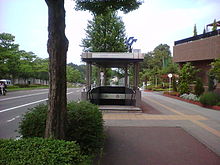- Nanboku Line (Sendai)
-
 The Sendai City Subway logo
The Sendai City Subway logo
Sendai City Subway Line Legend




km Station 




0 Izumi-Chūō 




1.2 Yaotome 




2.5 Kuromatsu 




Izumi-ku - Aoba-ku ward boundary 




3.3 Asahigaoka 




4.3 Dainohara 




5.4 Kita-Sendai 




Senzan Line 









6.6 Kita-yobanchō 




7.3 Kōtōdai-Kōen 




7.9 Hirose-dōri 









Senseki Line (Aoba-dōri terminal) 




Tōhoku Main Line (to Higashi-Sendai) 




Tōhoku Shinkansen (to Furukawa) 




8.5 Sendai 




Tōhoku Shinkansen (to Shiroish) 









9.4 Itsutsubashi 




Aoba-ku - Wakabayashi-ku ward boundary 




10.0 Atagobashi 




10.9 Kawaramachi 




Wakabayashi-ku - Taihaku-ku ward boundary 




11.7 Nagamachi-Itchōme 




12.4 Nagamachi 




Jōban Line 




Sendai Airport Line 




Tōhoku Main Line 









13.3 Nagamachi-Minami 




14.8 Tomizawa The Sendai City Subway Line (or Sendai City Underground Nanboku Line (仙台市営地下鉄南北線 Sendai shiei chikatetsu nanbokusen) as it is officially known) is a subway line in Sendai, Miyagi Prefecture, Japan. It connects Izumi-chūō Station in Izumi-ku, Sendai, with Tomizawa Station in Taihaku-ku, Sendai. This 1067 mm gauge line is 14.8 km long has 17 stations and runs on 1500 volt underground overhead electric system. The name Nanboku means north-south, which is the general direction that the track runs.
The Nanboku Line was the world's first public train to use fuzzy logic to control its speed, and is often used as an example in university courses on the subject of neural networks. This system (developed by Hitachi)[1] accounts for the relative smoothness of the starts and stops when compared to other trains, and is 10% more energy efficient than human-controlled acceleration[2].
Contents
History
- 1981 - Construction Started
- July 15, 1987 - From Yaotome Station to Tomizawa Station opened.
- July 15, 1992 - Line extended from Yaotome Station to Izumi-Chūō Station.
- March 11, 2011 - Damaged in the 2011 Tōhoku earthquake and tsunami and subsequently shut down for repairs.
- April 29, 2011 - Line reopenes after repair works were finished.[3]
Nanboku Line Station List
Rolling stock
- 1000 series
See also
References
- ^ Andrew Pollack (April 2, 1989). "Fuzzy Computer Theory: How to Mimic the Mind?". The New York Times. http://query.nytimes.com/gst/fullpage.html?res=950DE5DF133EF931A35757C0A96F948260&sec=&spon=&pagewanted=print. Retrieved 2007-10-31.
- ^ Philip Elmer-DeWitt (September 25, 1989). "Time For Some Fuzzy Thinking". Time. http://www.time.com/time/magazine/article/0,9171,958640,00.html. Retrieved 2007-10-31.
- ^ Kyodo News, "Sendai subway to fully resume operation April 29, earlier than planned", 6 April 2011.
External links
- (English) Sendai City Transportation Bureau Home Page
- (English) Urban Rail article on Sendai Subway
Categories:- Sendai City Subway Line
- Railway lines opened in 1987
Wikimedia Foundation. 2010.

